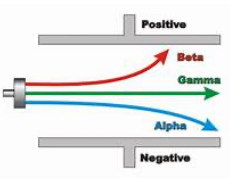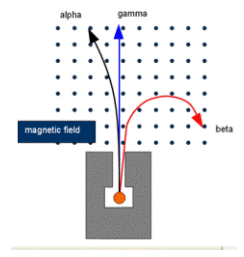Deflection (GCSE Physics)
Deflection
Deflection in an Electric Field
By observing the deflection of different particles, we can work out the charge of different particles in an electric field.
- Alpha particles move towards the negatively charged plate. Since they are attracted to a negative charge, this shows us that alpha particles carry a positive charge.
- Beta particles move towards the positively charged plate. Since they are attracted to a positive charge, this shows us that beta particles carry a negative charge.
- Gamma rays are unaffected. Gamma rays are uncharged, so are unaffected by the positive and negatively charged plates.

Deflection in a Magnetic Field
When charged particles cut through a magnetic field, a force is experienced. This can be described by the motor effect, which you will learn in more detail later on. This force can cause particles to become deflected.
- Alpha particles are deflected. By using Fleming’s Left Hand Rule, we can work out the direction of deflection. This deflection shows that alpha particles carry a positive charge.
- Beta particles are deflected. Similarly, beta particles are deflected however it is in the opposite direction to alpha particles. This means that they must carry an opposite charge to alpha particles – a negative charge. This makes sense as beta particles are fast-moving, negatively charged electrons.
- Gamma rays are not deflected. Gamma rays are uncharged, therefore unaffected when passing through a magnetic field.

Deflection refers to a change in the direction of a moving object, often caused by a force. In GCSE Physics, students learn about how forces can cause deflection in various physical systems, such as springs and beams.
Deflection is often measured as the amount of change in the direction of a moving object, such as the amount by which a spring compresses or a beam bends. This measurement can be expressed in units of length, such as millimeters or centimeters.
Deflection is important in GCSE Physics as it provides insight into the behavior of physical systems and the forces acting on them. By understanding deflection, students can analyze and design systems to ensure that they can handle the loads and forces they are subjected to in real-world applications.
Hooke’s law is a principle in GCSE Physics that states that the deflection of a spring is directly proportional to the force applied to it, provided that the limit of proportionality is not exceeded. This relationship between force and deflection is an important concept in understanding the behavior of springs and other elastic materials.
The deflection of a material is a measure of its strength and ability to resist forces without breaking. In GCSE Physics, students learn that the deflection of a material can provide information about its strength, toughness, and other properties. Materials with low deflection under a given load are considered to be stronger and more durable.
The relationship between force and deflection in GCSE Physics depends on the type of material and system being studied. In some cases, such as with springs, the relationship is described by Hooke’s law, which states that the deflection is proportional to the force applied. In other cases, the relationship may be more complex, involving factors such as the material’s elasticity, strength, and geometry.
In GCSE Physics, students learn how to use deflection to design safer and more effective systems. For example, by understanding the deflection of a material under a given load, engineers can determine the size and shape of components to ensure that they can handle the forces they will be subjected to in real-world applications. This can help to prevent failures, improve performance, and increase the overall safety and effectiveness of the system.





Still got a question? Leave a comment
Leave a comment